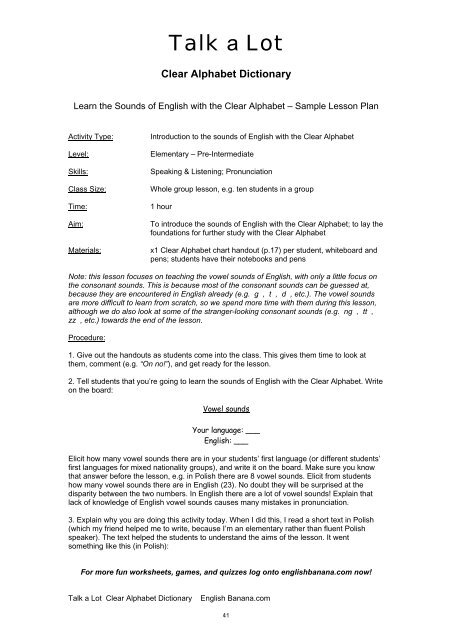14-Clear-Alphabet-Dictionary
You also want an ePaper? Increase the reach of your titles
YUMPU automatically turns print PDFs into web optimized ePapers that Google loves.
Talk a Lot<br />
<strong>Clear</strong> <strong>Alphabet</strong> <strong>Dictionary</strong><br />
Learn the Sounds of English with the <strong>Clear</strong> <strong>Alphabet</strong> – Sample Lesson Plan<br />
Activity Type:<br />
Level:<br />
Skills:<br />
Class Size:<br />
Time:<br />
Aim:<br />
Materials:<br />
Introduction to the sounds of English with the <strong>Clear</strong> <strong>Alphabet</strong><br />
Elementary – Pre-Intermediate<br />
Speaking & Listening; Pronunciation<br />
Whole group lesson, e.g. ten students in a group<br />
1 hour<br />
To introduce the sounds of English with the <strong>Clear</strong> <strong>Alphabet</strong>; to lay the<br />
foundations for further study with the <strong>Clear</strong> <strong>Alphabet</strong><br />
x1 <strong>Clear</strong> <strong>Alphabet</strong> chart handout (p.17) per student, whiteboard and<br />
pens; students have their notebooks and pens<br />
Note: this lesson focuses on teaching the vowel sounds of English, with only a little focus on<br />
the consonant sounds. This is because most of the consonant sounds can be guessed at,<br />
because they are encountered in English already (e.g. g , t , d , etc.). The vowel sounds<br />
are more difficult to learn from scratch, so we spend more time with them during this lesson,<br />
although we do also look at some of the stranger-looking consonant sounds (e.g. ng , tt ,<br />
zz , etc.) towards the end of the lesson.<br />
Procedure:<br />
1. Give out the handouts as students come into the class. This gives them time to look at<br />
them, comment (e.g. “On no!”), and get ready for the lesson.<br />
2. Tell students that you’re going to learn the sounds of English with the <strong>Clear</strong> <strong>Alphabet</strong>. Write<br />
on the board:<br />
Vowel sounds<br />
Your language: ___<br />
English: ___<br />
Elicit how many vowel sounds there are in your students’ first language (or different students’<br />
first languages for mixed nationality groups), and write it on the board. Make sure you know<br />
that answer before the lesson, e.g. in Polish there are 8 vowel sounds. Elicit from students<br />
how many vowel sounds there are in English (23). No doubt they will be surprised at the<br />
disparity between the two numbers. In English there are a lot of vowel sounds! Explain that<br />
lack of knowledge of English vowel sounds causes many mistakes in pronunciation.<br />
3. Explain why you are doing this activity today. When I did this, I read a short text in Polish<br />
(which my friend helped me to write, because I’m an elementary rather than fluent Polish<br />
speaker). The text helped the students to understand the aims of the lesson. It went<br />
something like this (in Polish):<br />
For more fun worksheets, games, and quizzes log onto englishbanana.com now!<br />
Talk a Lot <strong>Clear</strong> <strong>Alphabet</strong> <strong>Dictionary</strong><br />
English Banana.com<br />
41



